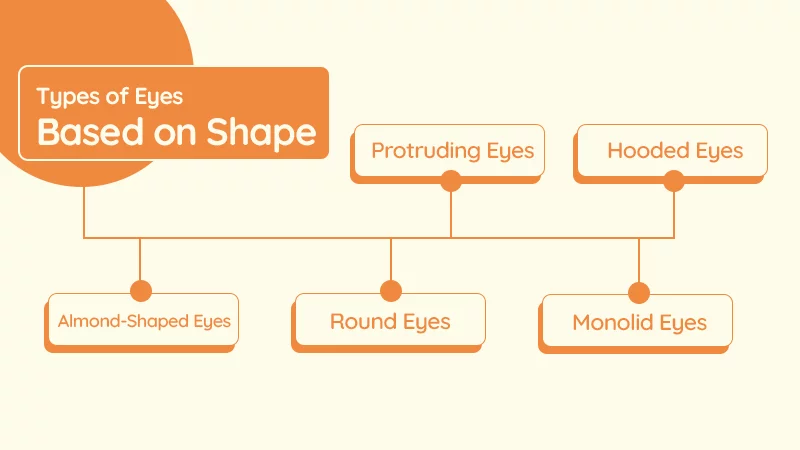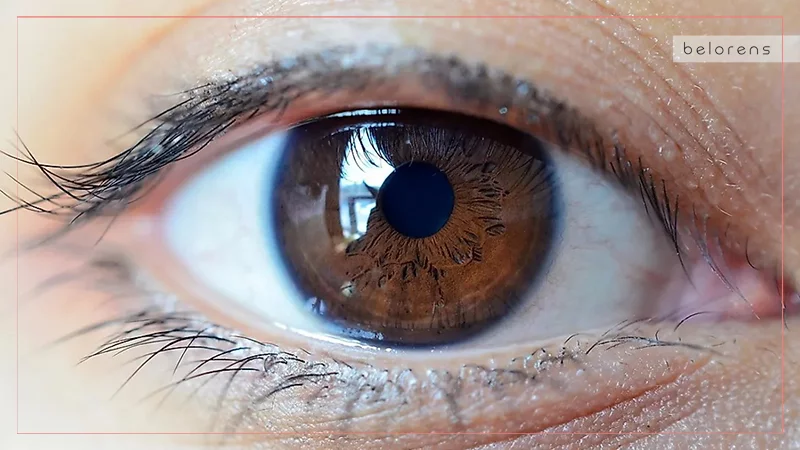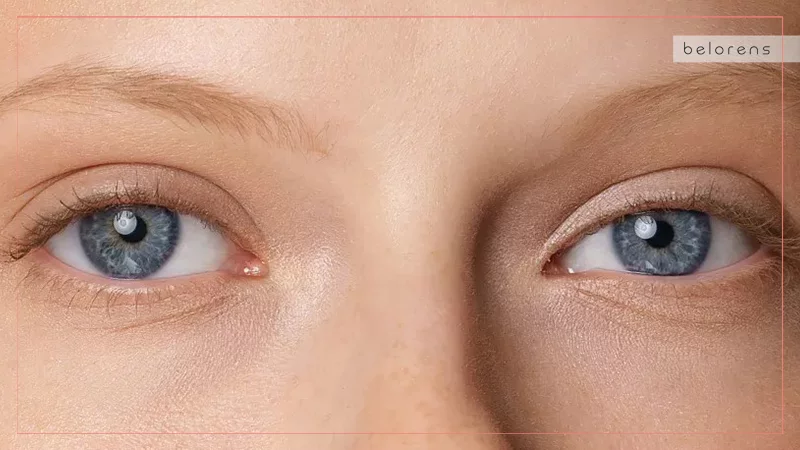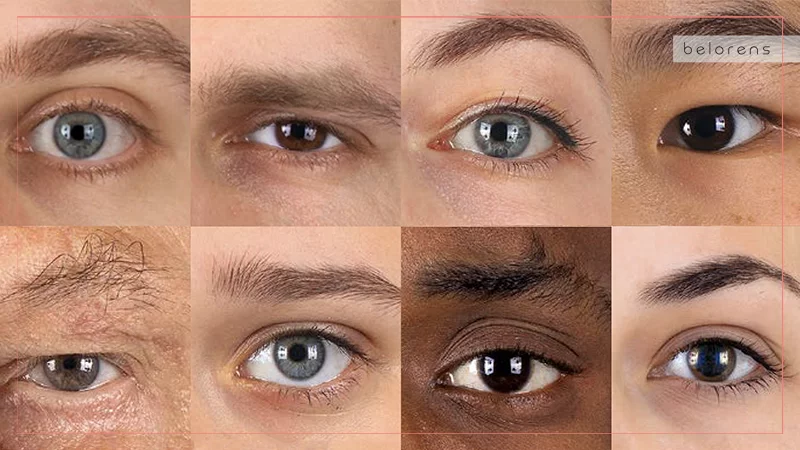Published on 11 Apr 2024
Exploring the Beauty of Different Types of Eyes Across Ethnicities, Colors, and Shapes
- ByMedical Content Team
- Medically Reviewed byDr. Sabine Kulhanek
Fact checked

- What Categorizations Are We Using to Explore Different Types of Eyes?
- The Role of Genetics in Eye Features
- Types of Eyes Based on Shape and Their Meanings
- Types of Eyes Based on Color
- Green Eyes: Shades of Nature
- Heterochromia: Separation of Colors
- Types of Eyes Based on Ethnicities: How Do Each of These Ethnic Eyes Blend Color and Shape?
- Word to the Wise: Belorens and Solutions for Types of Eyes
- FAQ
In this blog post, we go on a read to explore human diversity through the lens of one of our most expressive features: our eyes. From the shades of color that profess in the iris to the unique shapes and sizes that distinguish individuals across different ethnic backgrounds, each pair of eyes tells a story of heritage, biology, and the interwoven genetics of our ancestors. Understanding the types of eyes that exist in our world is more than an exercise of curiosity; it's a celebration of the beauty and individual uniqueness that defines us.
By delving into the various aspects of different types of eyes, including their ethnicity, color, and shape, we aim to appreciate the subtle nuances and the profound connections that link us to one another. Through this exploration, we invite readers to not only learn about the diversity that surrounds us but also to reflect on the shared humanity that eyes, in all their myriad forms, so beautifully reveal.
What Categorizations Are We Using to Explore Different Types of Eyes?
In our exploration of the types of eyes, we categorize these features using three primary methods: color, ethnicity, and shape. Each category offers a unique perspective on how eyes contribute to individual identity and reflect broader human diversity. Together, these three methods of categorization provide a comprehensive framework for understanding eye types. By examining color, ethnicity, and shape, we not only celebrate the diversity inherent in human eyes but also foster a deeper appreciation for the unique stories and shared experiences they represent.
Types of Eyes-Based Color
Eye color is perhaps the most visually striking aspect that differentiates types of eyes. It ranges from the deepest shades of brown to the lightest hues of blue and green, and even includes rarer colors like gray and amber. The color of the eyes is determined by genetics and the concentration of melanin in the iris, which can vary significantly across different populations and even within families. By examining eye color, we gain insights into ancestral origins and genetic inheritance, as well as the way in which human beings have adapted to their environments over millennia.
Types of Eyes Based on Ethnicity
The classification of various types of eyes based on ethnicity allows us to appreciate the diversity of eye features among various ethnic groups. This method considers how genetic backgrounds and geographical ancestry influence eye characteristics, including both color and shape. Ethnicity-related categorization highlights the beautiful variety of eye features found around the world, from the monolid eyes commonly seen in East Asian populations to the wide variety of colors and shapes observed in individuals of mixed heritage. This approach not only celebrates the unique beauty found in each ethnic group but also underscores the interconnectedness of the human family.
Types of Eyes Based on Shape
The various eye shapes play a crucial role in facial recognition and expression, impacting how we perceive emotions and expressions in others. Eye shapes can vary widely, including almond-shaped, round, hooded, monolid, and more. These variations in shape are influenced by genetics, ethnic background, and evolutionary factors. By exploring the different types of eyes based on shape, we delve into the subtleties of human expression and the ways in which our eyes communicate non-verbally with the world around us.
The Role of Genetics in Eye Features
Genetics plays a key role in deciding what types of eyes we get, including their color, shape, and other features. The color of our eyes depends on how much melanin, a natural pigment, we have in the iris, and this is determined by our genes. For example, certain genes decide whether we have blue, green, brown, or other eye colors. The shape of our eyes, like if they are round, almond-shaped, or have a fold of skin on the eyelid, is also something we inherit from our parents. Scientists have found specific genes that are responsible for these eye traits. This shows us how connected we are to our family and ancestors through our eyes and how people have adapted to where they live in the world over time.
Types of Eyes Based on Shape and Their Meanings
From the sleek elegance of monolid eyes to the expressive depth of protruding eyes, each shape carries its own beauty and significance. This section delves into the common eye shapes—almond, round, monolid, hooded, and protruding—exploring what these shapes typically signify and addressing their specific needs. By understanding the unique characteristics and requirements of each type of eye shape, we can appreciate the diverse tapestry of human beauty and learn how to accentuate these features in a way that celebrates individual uniqueness.
Almond-Shaped Eyes

Characterized by a slight point on the ends with a wider center, almond-shaped types of eyes resemble the nut they're named after. This shape is considered the most universally flattering and balanced. Almond eyes are often seen as the ideal eye shape due to their balanced proportions. They are associated with a wide range of cultural ideals of beauty. Almond eyes are quite versatile in terms of makeup and don't have specific needs. However, to enhance their natural beauty, applying eyeliner thicker in the middle can make them appear even more balanced. Mascara can be focused on the center lashes to maintain their proportional appearance.
Round Eyes
Round types of eyes are larger and more circular, making them appear more open and bright. The whites of the eyes are more visible around the top and bottom of the iris. They convey a sense of openness and curiosity, often giving individuals a youthful appearance. To elongate round eyes and give them a more almond-like appearance, makeup techniques can include applying darker eyeshadow at the outer corners and extending eyeliner beyond the eye's outer corners. This approach creates a more dramatic and mature look, reducing the eye's roundness.
Monolid Eyes
Monolid eyes feature a single eyelid without a crease, which is common among people of East Asian descent. The eyelid appears smooth, extending from the brow to the lash line. This eye shape contributes to a sleek and modern aesthetic, emphasizing the natural beauty of the eye without the interruption of a crease. For monolid eyes, makeup strategies often focus on creating depth and dimension. This can be achieved by applying layered eyeshadow with a gradient effect, darker at the lash line and lighter towards the brow. The eyeliner should be thicker to ensure it's visible when the eyes are open. False lashes or volumizing mascara can also help to open up the eyes more.
Hooded Eyes
With hooded eyes, the eyelid crease is not visible because it's covered by a protruding upper lid. This gives the appearance of smaller lids. Hooded eyes can lend a sophisticated and enigmatic look to the face, often creating a natural smokey eye effect. Hooded eyes benefit from makeup techniques that create the illusion of a more defined crease. Using matte eyeshadow above the natural crease line can help achieve this effect. Eyeliner should be applied thin at the inner corner and can be thickened towards the outer corner to enhance the eye's shape. Waterproof makeup is recommended to prevent smudging in the hidden crease area.
Protruding Eyes
Protruding types of eyes bulge outward from the eye socket, offering a large eyelid space. This shape allows for a lot of room to experiment with makeup. These eyes are often considered dramatic and expressive, capable of conveying deep emotions and enhancing the impact of eye contact. The key for protruding eyes is to use makeup to subtly downplay their prominence if desired. This can be done by using dark eyeshadows in matte finishes to add depth and reduce the appearance of protrusion. Blending eyeshadow well into the crease can also create a more subdued look. Eyeliner might be kept close to the lash line for a more defined shape.
Types of Eyes Based on Color
From the captivating depths of deep blue to the ethereal lightness of sea green, each one of the different types of eye colors unveils a world of beauty and distinction. This section explores the vibrant spectrum of eye colors—brown, blue, green, and the nuanced shades in between—revealing what these hues may signify and how they interact with the world. By delving into the unique aspects of each eye color, we uncover the ways in which they contribute to our identity and perception.
Types of Brown Eyes: A Spectrum of Warmth and Depth

Dark brown types of eyes, so deep in color they almost appear black, are a striking feature commonly seen in individuals from East Asia, Southeast Asia, and Africa. This eye color, rich in melanin, is known for its intensity and ability to absorb light, giving it a mysterious and captivating allure. For those with dark brown eyes, playing up their natural depth with equally rich eyeshadow colors like plum, deep green, or even metallic shades can enhance their dramatic effect. Eyeliners in jet black or dark brown can define the eye's shape, making the whites of the eyes appear brighter in contrast. Mascara can add the finishing touch by volumizing and lengthening the lashes, bringing attention to the eyes' profound depth and beauty.
Medium brown types of eyes offer a perfect balance of melanin, making them prevalent across many ethnicities worldwide. This versatile eye color pairs beautifully with a wide range of shades, from warm coppers and bronzes to cooler tones like lavender and navy blue. To highlight medium brown eyes, consider using complementary colors that sit opposite brown on the color wheel, such as teal or bright purple, to make the eyes pop. Eyeliners in earthy tones or navy can accentuate the eyes' natural warmth. For an everyday look, neutral eyeshadows in taupe or soft brown can subtly enhance the eyes while adding a bit of shimmer on the inner corners, which can brighten the entire eye area.
Light brown or hazel types of eyes are mesmerizing, with their specks of gold, green, or grey commonly found in Europe and the Americas. This eye color changes hue based on the lighting and colors around them, making them particularly unique. To accentuate light brown or hazel eyes, use eyeshadow shades that bring out the flecks of color in the iris, such as olive green, gold, or even rich browns, for contrast. Eyeliners in dark green or gold can underline the eyes' multifaceted colors. For a bold statement, a swipe of bright eyeliner like emerald or gold on the lower lash line can draw attention to the eye color's complexity. Finishing with mascara that defines and curls the lashes will ensure that the eyes' sparkling hues are not overshadowed, highlighting their natural beauty and distinctive colors.
Types of Blue Eyes: From the Sea to the Sky

Deep Blue types of eyes with their strikingly intense hue are prevalent in Northern Europe, and offer a captivating look but come with a higher sensitivity to light due to the lower melanin content. Individuals with deep blue eyes should prioritize wearing UV-protective sunglasses when outdoors to shield their eyes from harmful sun exposure, which can increase the risk of eye health issues over time. Emphasizing the importance of regular eye check-ups can help detect any potential concerns early, such as damage from UV exposure or developing conditions like photokeratitis.
Sky blue types of eyes are known for their light, almost ethereal appearance and are a common trait among Eastern and Northern European populations. The transparency of this eye color makes it particularly vulnerable to bright lighting and UV rays. People with sky-blue eyes can benefit significantly from wearing broad-spectrum sunglasses and hats when exposed to sunlight to protect against UV damage and discomfort. Integrating foods rich in lutein and zeaxanthin, such as kale and spinach, into their diet can also support retinal health and combat the effects of blue light exposure.
Grey-Blue types of eyes are a unique blend of blue with grey undertones, varying in intensity, combining the aesthetic allure of blue eyes with added depth. Due to their lighter pigmentation, grey-blue eyes are more susceptible to glare and sunlight. Using polarized sunglasses can help reduce glare, improving visual comfort in bright environments. Furthermore, maintaining a diet that includes omega-3 fatty acids, found in fish like salmon and flaxseeds, can enhance visual acuity and prevent dry eyes. Regular screenings for conditions such as cataracts and macular degeneration are also advisable to preserve eye health and vision quality.
Green Eyes: Shades of Nature

Forest green types of eyes are characterized by their rich, vibrant hue and are a rare sort that is predominantly found in Iceland and Northern Europe. Their deep coloration, while stunning, means they share similar light sensitivity traits with other light-colored eyes. To safeguard these precious orbs, individuals should opt for high-quality, UV-protective sunglasses when outdoors. Additionally, engaging in eye health practices like taking breaks during screen time to reduce eye strain and ensuring adequate lighting in workspaces can prevent unnecessary stress on the eyes. Consuming foods rich in vitamin A, such as sweet potatoes and carrots, can further support eye health by enhancing vision in low-light conditions.
Hazel Green types of eyes blend green and brown, often highlighted by a distinctive starburst pattern around the pupil, making each eye uniquely captivating. Hazel green eyes can vary in their response to light, given the mixed pigmentation. Protective measures against UV light, including the use of sunglasses and protective lenses, remain crucial. Those with hazel green eyes might also benefit from using eye drops to maintain hydration, particularly in dry or air-conditioned environments, which can cause irritation. Including foods high in vitamin E, like nuts and seeds, in one's diet can help protect the eyes from oxidative stress and maintain healthy vision.
Sea green types of eyes, with their lighter hue and sometimes golden flecks, possess an ethereal quality that captures the light in a unique way. This lighter pigmentation increases sensitivity to bright light, making it essential for individuals to protect their vision with sunglasses that offer complete UV protection. Polarized lenses can be particularly beneficial for reducing glare, especially near water or while driving. To support the health of these captivating eyes, incorporating zinc-rich foods such as oysters and beef into the diet can help maintain the health of the retina and potentially improve night vision. Regular eye exams are important to monitor for any potential issues early on, ensuring the longevity of eye health and vision clarity.
Grey Eyes: Rarest Type of Eye Color
Dark Grey types of eyes carry the intensity of a stormy sky, a deep charcoal grey that commands attention due to its rarity. The dark grey hue provides a certain level of protection from sunlight, similar to darker eye colors, yet individuals with this eye color should not forego protective measures. Sunglasses with complete UV protection are essential to guard against potential sun damage and reduce glare, which can enhance visual comfort in bright environments. Regular eye examinations are crucial to monitor for any conditions that might be more prevalent with lower melanin levels, ensuring that the mystique of these eyes is maintained through optimal health.
Light grey types of eyes, with their near-silver sheen, possess a chameleon-like quality, often reflecting blue or green tones under different lighting. This variability adds to their allure but also means they share the increased sensitivity to light found in other light-colored eyes. To combat this sensitivity, individuals with light grey eyes should prioritize wearing sunglasses that offer protection against both UVA and UVB rays, minimizing the risk of discomfort and long-term damage from exposure to the sun. Including foods rich in vitamins A, C, and E in the diet can support eye health, protecting against age-related deterioration and maintaining the clarity and sparkle of these captivating eyes. Regular eye health check-ups can help to ensure that any potential issues are caught early, preserving the unique beauty and health of light grey eyes.
Also Read: All You Need to Know About Skin Tone and Undertone
Heterochromia: Separation of Colors
One of the rare types of eyes, complete Heterochromia is a phenomenon where each eye is a distinct color, presenting a captivating and rare beauty that defies the commonality of uniform eye colors. This unique feature can be a conversation starter and a hallmark of individuality. Individuals with complete Heterochromia should protect their eyes from the sun, as each eye might react differently to light exposure. Sunglasses offering 100% UV protection are recommended to safeguard against potential damage. Regular eye examinations are essential, not only to monitor the health of each uniquely colored eye but also to ensure that the condition remains purely cosmetic and does not indicate underlying health issues.
Partial heterochromia is a distinct type of eye that involves a segment of one iris that has a different color from the rest of the eye, creating a captivating and unusual appearance. Partial Heterochromia highlights the intricate genetic expressions that define our individuality. Eye care for those with partial Heterochromia mirrors that of anyone aiming to maintain optimal eye health: wearing UV-protective eyewear and consuming a diet rich in vitamins C and E can help protect the eyes from environmental stresses and nutritional deficiencies. Periodic eye checks are advisable to keep an eye on the health of the iris and to detect any changes early.
The rarest types of eyes with different colors, central Heterochromia is characterized by an iris that displays two distinct colors—typically with the inner ring being a different hue than the outer—central Heterochromia is a mesmerizing trait. It often gives the eyes a multifaceted, jewel-like quality that can enchant onlookers. For those with central Heterochromia, maintaining eye health includes regular visits to an eye care professional to ensure that the variation in coloration is not linked to any vision or health problems. Protective measures like wearing sunglasses in bright sunlight can help manage light sensitivity, especially if one of the colors is lighter and more susceptible to glare.
Types of Eyes Based on Ethnicities: How Do Each of These Ethnic Eyes Blend Color and Shape?

Lastly, we have ethnic types of eyes, or eyes based on ethnicity. These types are the manifestation of how the previous two categorizations come together from distinct types of eyes that are so well known to represent different peoples.
Asian Eyes
Predominantly showcasing dark brown types of eyes, Asian ethnicities offer a unique beauty reflective of their rich cultural tapestry. The eyelid shape is notably diverse within this group, with monolids being a distinctive feature among East Asians. This eye characteristic contributes to a sleek and elegant appearance, and understanding the specific eyelid structure can enhance visual health strategies. Protective eyewear and regular eye health check-ups are essential, considering the variety in eyelid shapes, to prevent and treat conditions like dry eyes or vision strain effectively.
African Eyes
African populations are known for their deeply pigmented dark brown eyes, mirroring the diversity and depth of the continent itself. The eye shape among Africans is varied, featuring both wide and narrow palpebral fissures, reflecting genetic diversity. This variation necessitates a broad approach to eye care, emphasizing the importance of sun protection in regions with intense sunlight and regular eye examinations to catch any issues early, ensuring the maintenance of optimal eye health.
European Eyes
Europeans are characterized by a wide spectrum of eye colors, from the lightest blues to the deepest browns, accompanied by a significant variation in eye shapes, often with larger palpebral fissures. The diversity in eye color and shape within European populations suggests the need for personalized eye care, focusing on UV protection and dietary choices rich in antioxidants to support eye health across this varied palette.
Hispanic/Latino Eyes
Hispanic and Latino types of eyes feature a beautiful range of colors, including dark brown, green, and hazel, with eye shapes that blend indigenous, European, and African traits. This mix results in unique eye aesthetics, necessitating an inclusive approach to eye care that accounts for the varied susceptibility to sunlight and other environmental factors. Emphasizing the use of sunglasses with proper UV protection and regular eye health screenings can help address the specific needs of this diverse group.
Middle Eastern Eyes
Middle Eastern types of eyes are predominantly dark brown, with instances of green and hazel, and are often almond or oval-shaped with pronounced eyelashes. The intensity of sunlight in the region makes UV protection a critical aspect of eye care, along with the management of environmental factors such as sand and dust. Regular comprehensive eye exams are key to maintaining eye health, especially considering the unique combination of eye color and shape within the Middle Eastern populations.
Also Read: Celebrating Diversity: Exploring the Fascinating World of Nose Shapes Across Ethnicities
Word to the Wise: Belorens and Solutions for Types of Eyes
Now we know how types of eyes are categorized! In wrapping up our exploration of eye diversity across various eye colors, shapes, and ethnicities, it's clear that each person's eyes are unique. For those seeking guidance on eye-related aesthetic concerns, Belorens offers a straightforward solution. Our platform helps you find personalized treatments based on budget, preference for treatment intensity, location, and other criteria. You can view before and after photos, engage in discussions, and locate trusted medical professionals globally. Belorens simplifies the process of addressing and finding eye solutions for aesthetics, providing you with the information and resources needed to make informed decisions tailored to your specific needs and preferences.
Want mesmerizing eyes? Explore our comprehensive list of cosmetic eye procedures and give your eyes the stunning transformation they deserve!
FAQ
What determines eye color?
Eye color is primarily determined by genetics and the amount of melanin in the iris. Parents' genes combine in various ways, leading to the wide spectrum of eye colors seen in humans.
Can different types of eye shapes affect vision?
Generally, eye shape itself doesn't directly affect vision; however, certain eyelid shapes can influence eye health and comfort, such as monolids potentially contributing to dry eyes due to less protection over the eye.
Are certain types of eyes more sensitive to sunlight?
Yes, lighter eye colors like blue, green, and gray have less melanin, making them more sensitive to sunlight. Individuals with lighter eyes should ensure they have adequate protection against UV rays.
How does ethnicity influence eye features?
Ethnicity can influence eye features through genetic predispositions to certain eye colors, shapes, and eyelid types. These traits have developed over generations and have been influenced by geographical and environmental factors.
Can I change my eye color or shape to other types of eyes?
While eye color is generally fixed, certain contact lenses can temporarily change its appearance. Cosmetic surgery can alter eyelid shape, but such procedures should be considered carefully and discussed with a medical professional.




